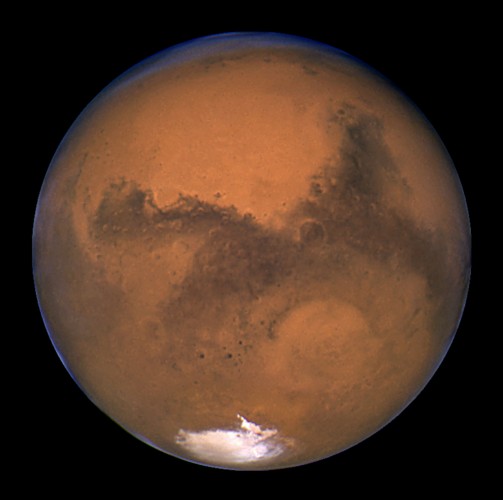
A view of Mars made from a series of exposures taken over a fify-two minute period. (Photo by J. Bell/M. Wolff/Reuters/NASA)
NASA’s Mars Reconnaissance Orbiter (MRO) has been surveying the planet’s surface since 2006 and has now provided the ‘strongest’ evidence that liquid water is currently flowing on Mars’.
Researchers found signatures of hydrated minerals on the Red Planet, appearing as dark downward flowing streaks on slopes the MRO studied. These are known as recurring slope lineae (RSL) and they disappear and reappear based upon the warm and cool seasons.
“Our quest on Mars has been to ‘follow the water,’ in our search for life in the universe, and now we have convincing science that validates what we’ve long suspected … This is a significant development, as it appears to confirm that water — albeit briny — is flowing today on the surface of Mars.
– John Grunsfeld, astronaut and associate administrator of NASA’s Science Mission Directorate

Dark narrow streaks called recurring slope lineae emanating out of the walls of Garni crater on Mars.
Credits: NASA/JPL/University of Arizona
Scientists say they have detected hydrated salts on the slopes which in turn lower the freezing point of liquid brine, equating to a ‘shallow subsurface flow’ with enough water ‘wicking to the surface’ to explain the darkening of the RSL. MRO was in the Martian Hale Crater when the hydrated minerals were discovered.
“We found the hydrated salts only when the seasonal features were widest, which suggests that either the dark streaks themselves or a process that forms them is the source of the hydration. In either case, the detection of hydrated salts on these slopes means that water plays a vital role in the formation of these streaks,”
– Lujendra Ojha of the Georgia Institute of Technology (Georgia Tech) in Atlanta, lead author of a report on these findings published Sept. 28 by Nature Geoscience.
NASA continues the discovery in further detail here and released a video explaining this exciting breakthrough:
What About Life?
“It seems that the more we study Mars, the more we learn how life could be supported and where there are resources to support life in the future.”
– Michael Meyer, lead scientist for NASA’s Mars Exploration Program, September 28th, 2015
In light of this new finding, I’d like to present a simulation conducted at the University of Michigan, which has pointed to the notion that perhaps 50% our water is a result of something that predates not only the solar system, but the Sun as well.
One researcher who conducted the simulation, Ilse Cleeves explained the true magnitude of what may have been found:
“The implications of these findings are pretty exciting, if water formation had been a local process that occurs in individual stellar systems, the amount of water and other important chemical ingredients necessary for the formation of life might vary from system to system. But because some of the chemically rich ices from the molecular cloud are directly inherited, young planetary systems have access to these important ingredients.”
So in simple terms, every single star may give solar systems the ingredients for life right off the bat via their very formation. If every solar system with a star inherently possessed some of the compounds needed for life, what does this NASA discovery really mean?
Let us know what you think below in the comment section.
By Alec Cope | We Are Change











Sign up on lukeunfiltered.com or to check out our store on thebestpoliticalshirts.com.